From nausea-inducing necessity to horrifying delicacy, the culture of cultures is a gross one.
Within moments of showing up at Giannetto’s farm, a scrubby stretch of pastures and vineyards a few miles outside the southern Sardinian town of Dolianova, the old man decides that we ought to slaughter a goat. I think momentarily about protesting that a whole beast is too much food for the five people on the farm that day. But I feel it would be rude to refuse the hospitality, as it is woven deeply into the shepherding culture of inland Sardinia. Plus, Giannetto may be graying and portly, but he’s still built like a brick wall. Even a friendly don’t-sweat-it slap on the back with his André the Giant hands would probably send me flying. So I just nod. Within minutes, Giannetto vanishes over a hillock, only to return swinging a baby goat upside-down by the legs; Sardinian tradition maintains that young animals have the most delicious flesh. The kid looks about nonchalantly and does not so much as bleat.
As prodigious head-to-hoof eaters, farmers like Giannetto can render a lot of meat off of even a little corpse like this one. Depending on the occasion, the creature’s blood can be used for a soup like sanguinaccio. The organs can be skewered and wrapped in intestine and diaphragm to make the savory holiday treat su cordula, although the kidneys and testicles are often roasted on their own, and the liver is sometimes eaten raw at the site of the slaughter. The whole goat can be roughly quartered and roasted over an open flame. And if you manage to catch the kid at just the right age—between two and three months old, before it’s started eating grass—you can even make a potent (and ostensibly illegal) form of soft cheese out of the mother’s milk in its raw, steaming stomach.
This peculiar cheese—known as caligù or su callu, depending on whom you talk to—is one of Sardinia’s lesser-known but more ubiquitous specialties. It’s also one of the most primal dairy products you’ll encounter in the modern world. Upon killing a kid, a farmer simply takes its milk-filled stomach, ties it off in a tight knot or sews it shut, perhaps covers it in mesh to keep the flies off, then hangs it from the ceiling of a cool, dark room. He then waits for a few months until the natural rennet within curdles and hardens the milk into a thick, creamy cheese and desiccation tightens the gut into a pungent, leathery rind.
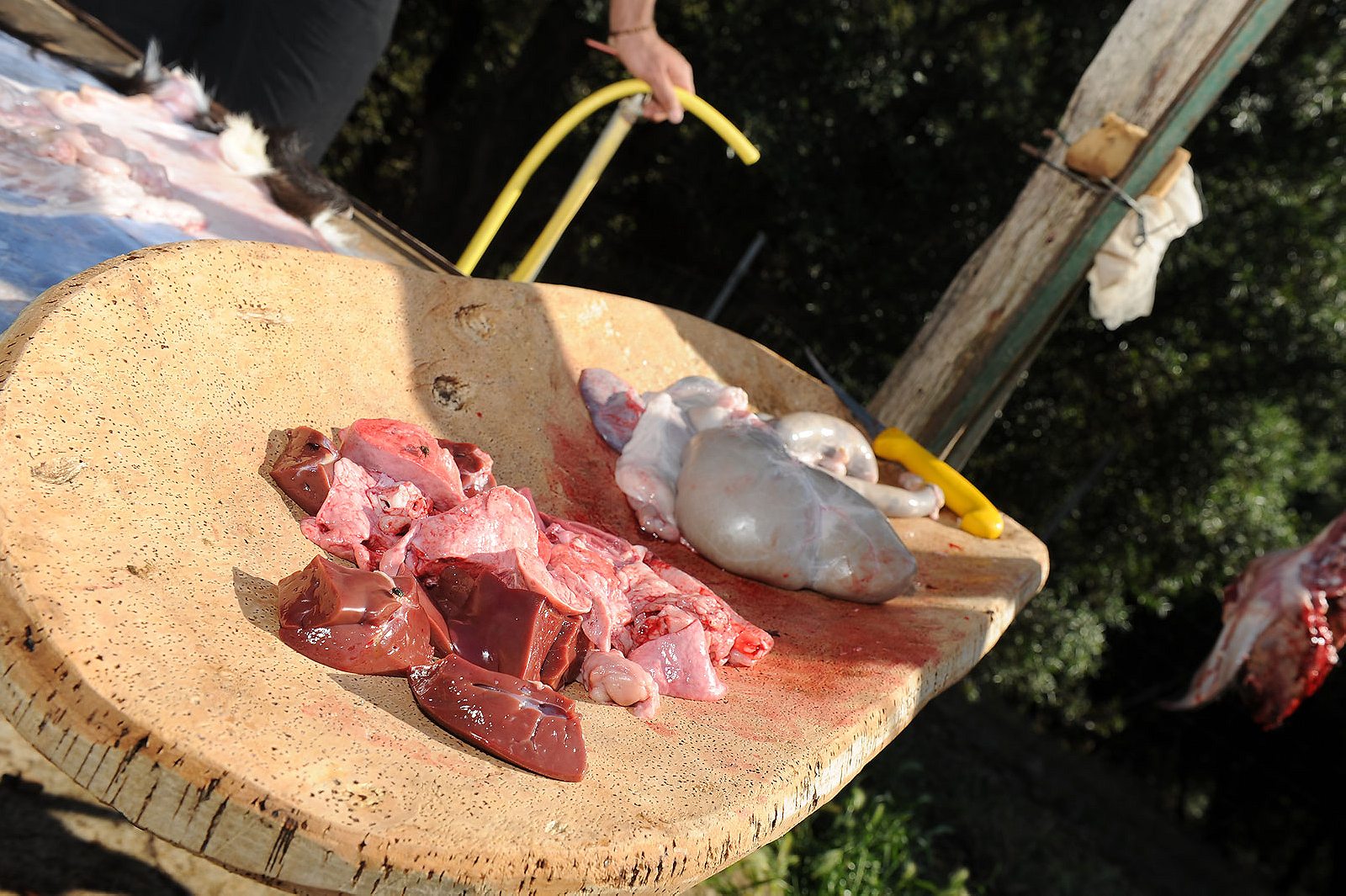
We all got to take a bite out of our kid’s bloody, hot, raw liver and it was young enough that it had only milk in its stomach, but unfortunately, it also had a tapeworm, eliminating it as a candidate for cheese production. However, Giannetto assures me that in one of his many little barns, past legs of peppered prosciutto and slabs of fatty cheek, there’s a rafter strung up with a good handful of caligù, a batch of which is ready to be consumed. And later that night, after we’ve put away our fair share of goat flesh, flatbread, baked cheese and fresh honey, tomatoes and cucumbers, and homebrew booze, he suddenly materializes one of the brown-red, triangular batches. His son, Andrea, who imports Sardinian specialties to France, splits it open with a vivisection cut down the center to reveal an off-white paste studded with the nipple hairs of a nanny goat, gulped down with its milk by a braying baby. As he spreads some on a bit of pane carasau and proffers it to me, the phlegmatic and philosophical Andrea muses, “This is a strong cheese. It is, maybe, the real, original cheese.”
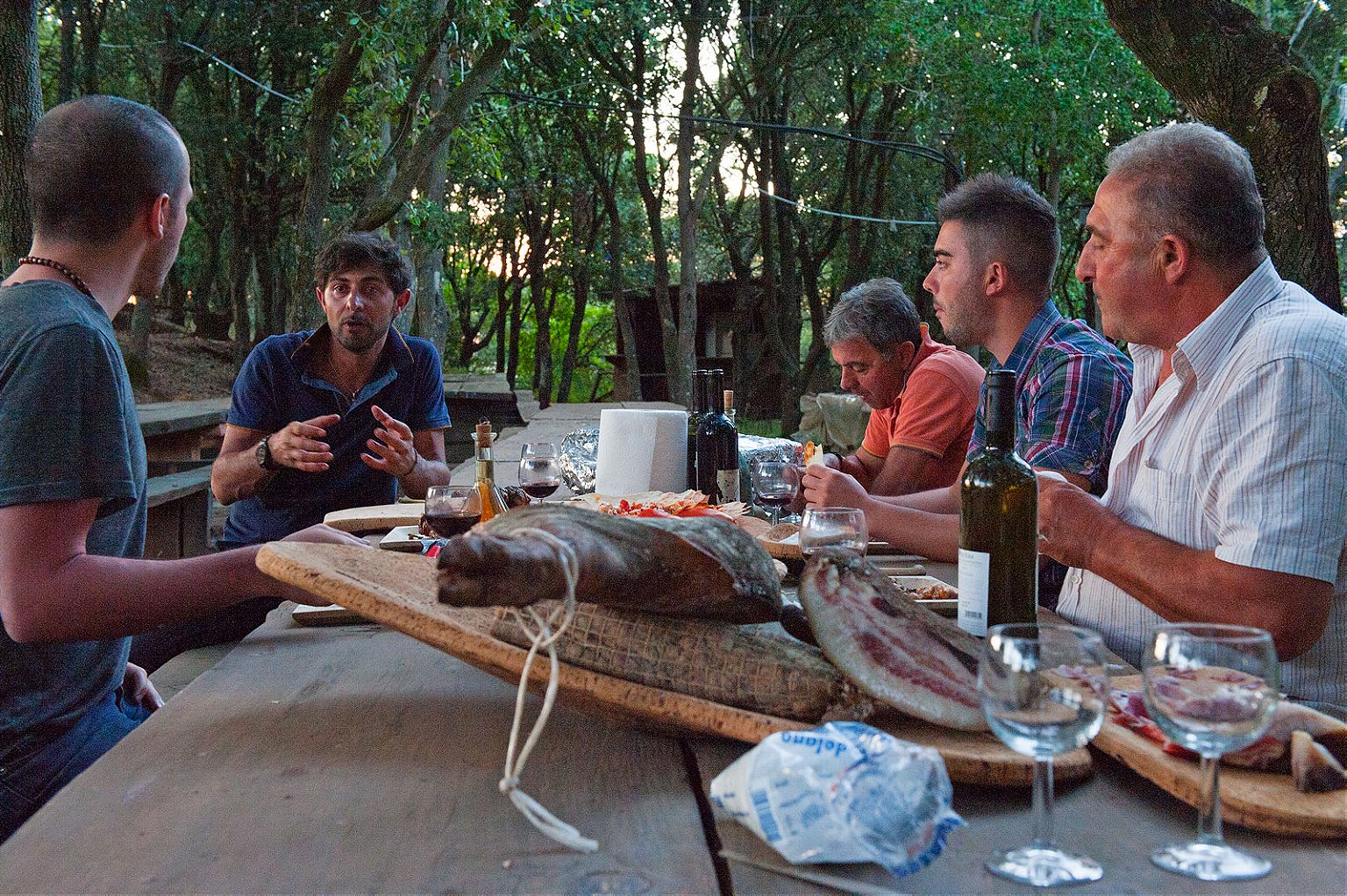
Andrea’s engaging in a bit of culturally self-aggrandizing dinner-table anthropology. But he might not actually be far off the mark. Caligù probably does resemble some of the world’s earliest cheeses, discovered accidentally and eaten for sustenance rather than taste in times of scarcity. That doesn’t explain, however, why we continue to embrace caligù and other cheeses with challenging flavors, unsanitary origins, and desperate pedigrees now that scarcity is, for much of the world (and especially the majority of cheese-loving countries), a thing of the past.
These days, you can find about 5,000 varieties of cheese, and about 11 billion pounds of it is produced annually around the world. But for all the variations in texture, odor, and taste, all cheeses stem from the same basic process: Bacteria and rennet mix with milk, separating the watery whey from the solid casein proteins of the dairy, coagulating the latter into curds.
Thereafter, different cheese varieties emerge based on a number of factors: the type of milk used, the amount of processing, and the size to which they are cut. Cheese producers must also decide whether to heat and stir or pressing and knitting the cheese, and whether to rub them with salty solutions or submerge them entirely to draw out more watery whey. When combined with the effect of local environmental factors and contaminants (some introduced intentionally, some unintentionally), cheese develops highly differentiated characteristics. But no matter how radical the cheese you’re aiming to make, the heart of the process is rennet introduction.
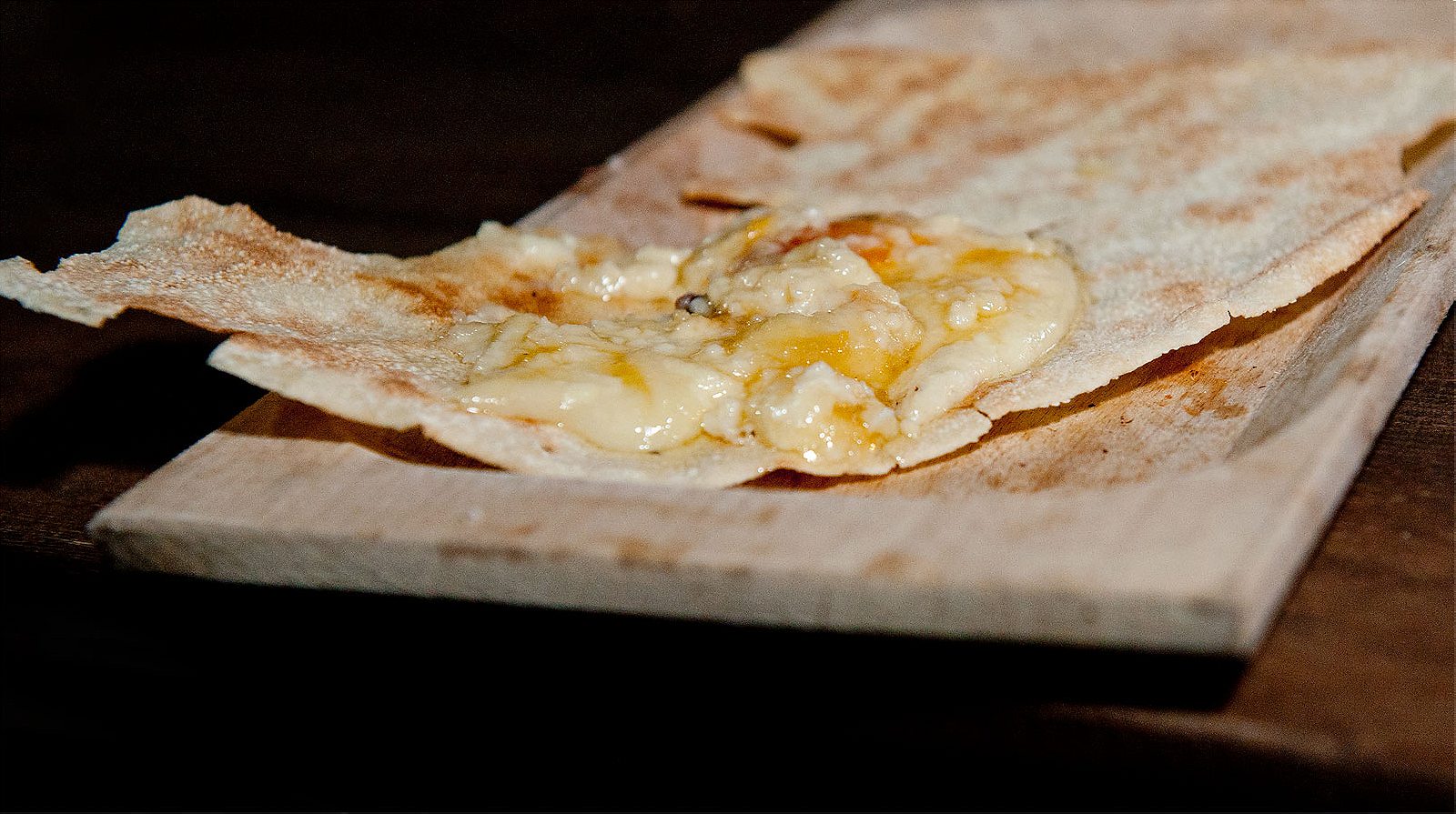
Since the late 18th century, cheese makers have had access to industrialized rennet—ready-to-use cultures, allowing anyone with access to milk to produce curds. Before that, most dairy workers used the remains of a previous cheese batch. But at the start of cheese production, rennet needed to come directly from an animal’s stomach.
It’s unlikely harvesting rennet out of a stomach is something a person would figure out how to do without having seen the effect of the enzymes on dairy in a gut environment. That means that, in all likelihood, cheese was discovered when someone inadvertently created caligù (or something very much like it) in an unattended stomach filled with milk, either post-slaughter as in caligù, or after using an empty stomach to store hand-milked dairy and leaving it too long.
An old legend, oft repeated in dairy circles, holds that this accidental discovery occurred about 9,000 years ago, when an Arab traveler using a stomach to store dairy went to take a swig of milk after a long day on the road and found that in the heat, rennet, bacteria, and other contaminants had created curds within the container.
We’re now pretty sure that this old tale is bullshit. According to Paul Kindstedt, a cheese biochemist and historian at the University of Vermont (of course), as of 7000 B.C., most adults worldwide were lactose intolerant. But early herders, and agriculturalists around whose crops herd animals congregated, got the bright idea to supplement human mothers’ milk with animal milk to provide a extra caloric security for babies and toddlers.
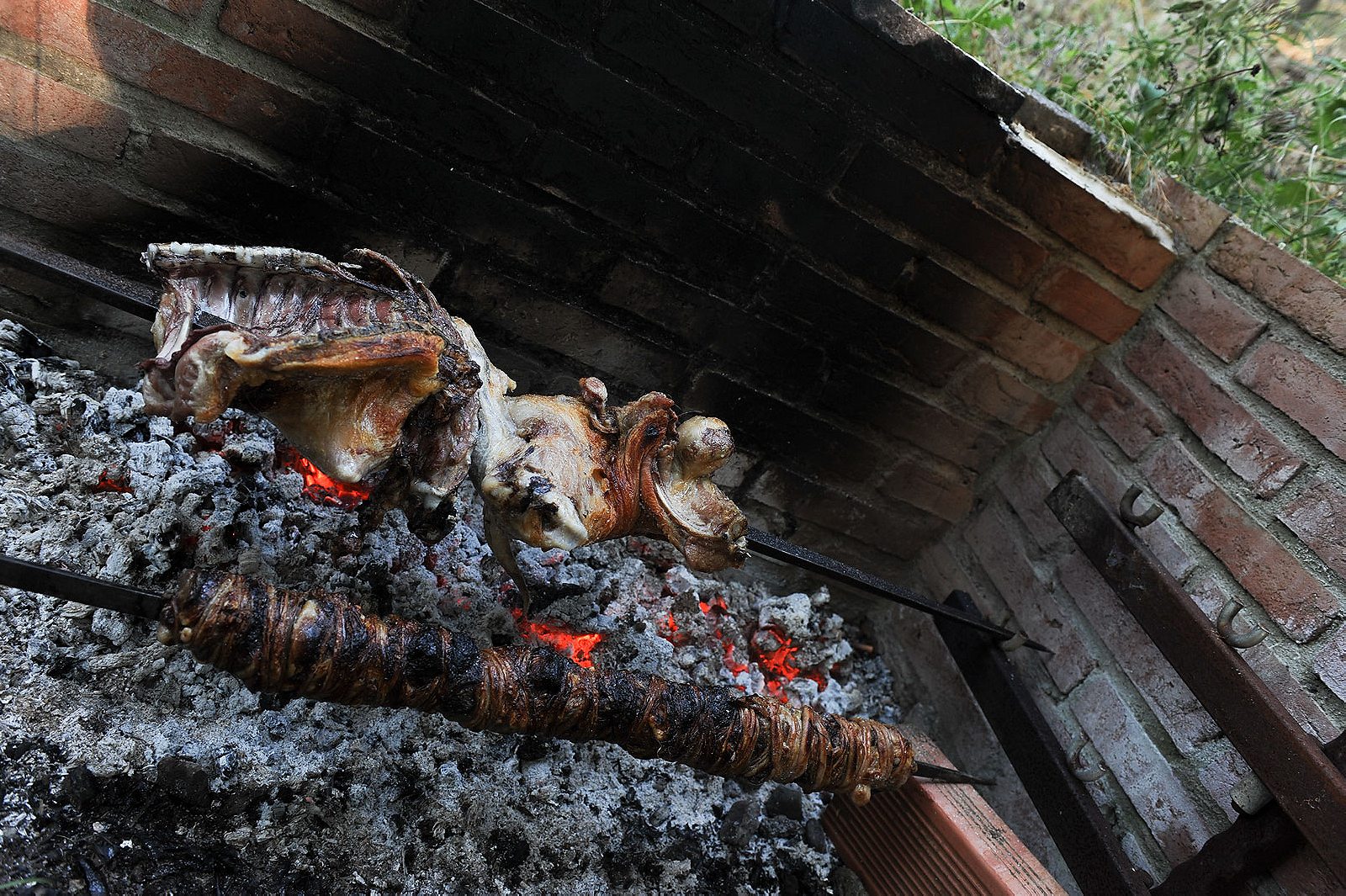
Kindstedt suspects that from there, in a period of intense food scarcity, some adults started risking the upset stomach dairy gave them. They would eventually try eating the curds left behind in seemingly spoiled milk in stomach skins, only to discover that (thanks to the fact that separating whey from curds removes up to 80 percent of dairy’s gastrointestinally offensive lactose) they could stomach it better than the straight liquid they gave to their kids.
From there, they observed that these curds were compact (usually a tenth of the volume of the milk used to make them), less perishable than many foods, and malleable in their flavors and consistencies. Experimenting with cheeses, especially via salting and pressing to increase desiccation (and thus shelf life) was a Neolithic food-security revolution.
Milk fat found in pottery in the Fertile Crescent suggests the intentional production of cheese as of 6500 B.C., while some argue that its true origins might date back to Turkey circa 7500 B.C. Either way, Kindstedt believes that around 5500 B.C. Middle Eastern and European peoples bred out their lactose intolerance due to long-term reliance on cheese as a scarcity food. People choked it down because it was seen as a necessity, despite centuries of upset stomachs.
A creamy sludge with a monstrous taste and the stench of death about it
The reliance on cheese as a means of survival probably accounts for our historical tolerance for spoilage and even outright rot in our cheese. The pinnacle of this tolerance may actually be yet another Sardinian cheese: the infamous casu marzu (literally: rotted cheese). The cheese is known amongst daring foodies for incorporating live larvae, probably originally accidentally introduced but now enticed into a pecorino sheep’s cheese left out in the open sky with its top rind cut off. Once inside, these maggots digest the cheese, secreting lagrima (“tears” of gastric byproduct known to forensic entomologists as “black putrification”) and churning it into a creamy sludge with a monstrous taste and the stench of death about it.
The death of the maggots means the cheese is no longer edible, so most Sardinians eat the cheese with the live maggots inside of it (although a few suffocate them to death in a paper bag, then pick them out just before eating). This leads to a few problems, as the larvae of this particular bug (the Piophila casei) can coil themselves into such a tight ball that when they release their tension, they can fly half-a-foot in an astounding escape mechanism, sometimes into the eye of an eater. Plus, these maggots are shockingly resistant to stomach acid, allowing some to thrive in an eater’s intestines, creating a bloody case of myiasis.
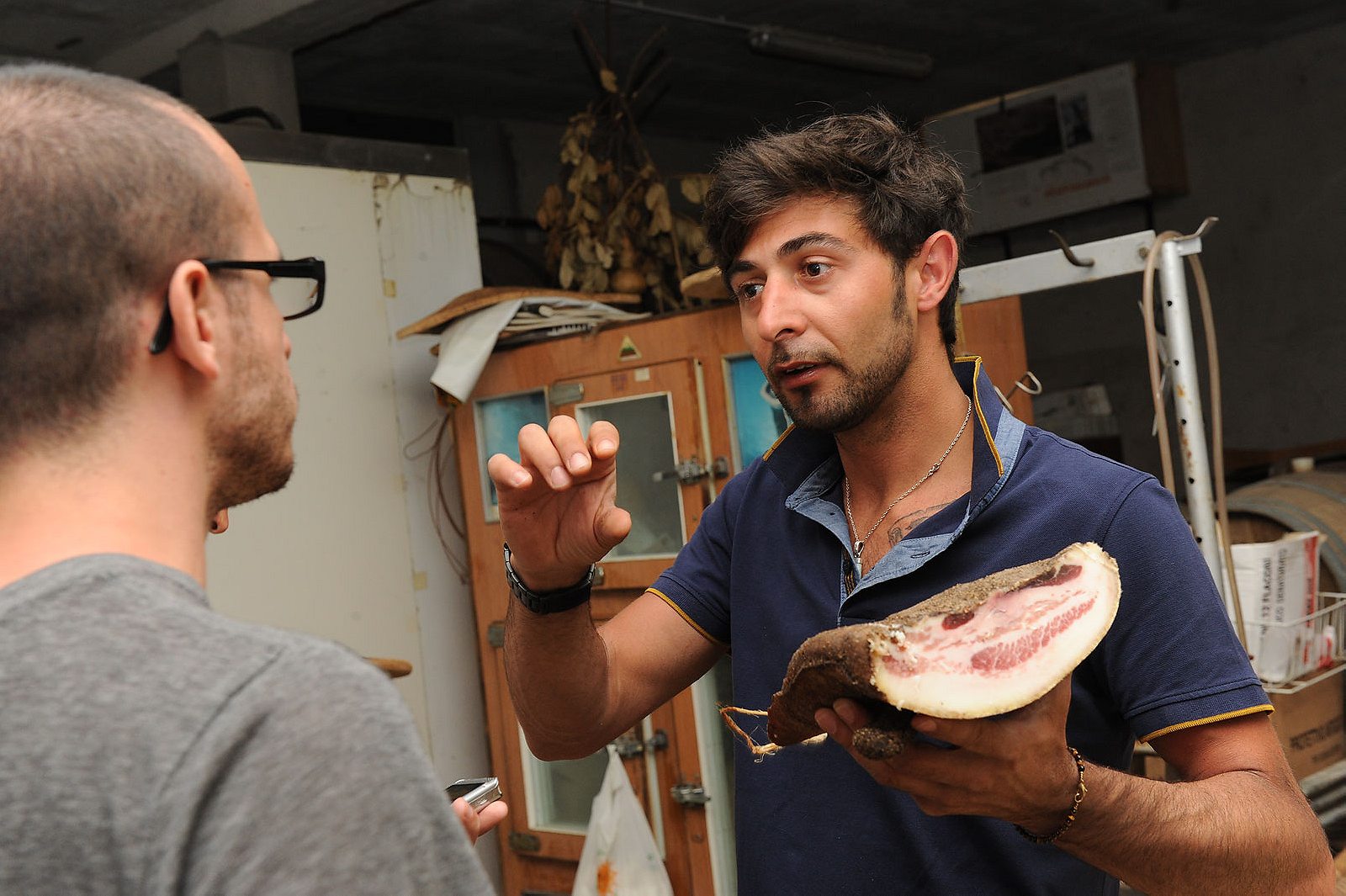
“My guess,” says Kindstedt of Sardinians’ willingness to eat clearly rotted cheese despite the danger and humanity’s general aversion to other maggoty foods, “is that cheese was such an important element of the subsistence strategy in many of the marginal agricultural regions round the Mediterranean that a tolerance for non-lethal ‘spoilage’ provided a significant survival advantage, which ultimately became institutionalized through cultural embracement.”
That’s the truly weird thing about cheeses like casu marzu and caligù: even now that they’re no longer necessary for survival, somehow over the years they’ve knitted themselves into the core of Sardinian identity. It’s certainly not because of their taste: When I bite into the smear of caligù Andrea hands me, it’s all I can do to keep a neutral expression. The cheese burns like a shot of serious whiskey, magnified threefold. I’m told that some Sardinians now sieve the milk out of the stomach to remove hairs, and add extra milk to the original batch to shift the rennet-to-dairy ratio and smooth out the flavor. But that seems to be frowned upon as an effete adjustment to the modern era by traditionalists and is not the case here. The nanny goat’s hairs scrape over my tongue, and the lurking tang of ammonia numbs my mouth and seeps into my nasal passageway, lingering for ages.

Andrea catches the panicked glint in my eyes and smirks. He tells me that, while this is a man’s cheese, true men like Giannetto take things even further. They eat the remains of the stomach rind in their morning eggs after a good night of feasting, a wake-up to put hair on your chest, and a tradition that Andrea says that even he, a former-farm-boy-foodie, can’t quite stomach.
Embracing extreme cheeses once eaten as accidents or out of necessity, working them into the core of a region’s sense of culinary identity as a local delicacy, isn’t just a Sardinian habit. Challenging cheeses abound in Europe: Abruzzo’s cace fraceche, Apulia’s formag punt, Calabria’s casu du quagghiu, Corsica’s casgiu merzu, Emilia Romagna’s furmai nis, France’s mimolette, Friuli Venezia Giulia’s saltarello, Liguria’s gorgonzola co-i grilli, Molise’s cacie’ punt, and Würchwitz’s milbenkäse all include live or recently dead insects as well. Some cheeses, like France’s epoisses or vieux lille, are so strongly flavored and perfumed that locals won’t allow them to be opened within closed quarters.
For the many cultures that don’t grow up acquiring the taste, all cheeses are insane cultural hangovers. To someone unused to Parmesan, for example, that cheese tastes of vomit. That’s why the world needs an entire WikiHow page devoted to learning to like cheese, with step-by-step guides to weaning yourself onto this curdled, fermented, spoiled dairy, often by pairing it with more palatable, masking flavors. It’s also why it’s been so hard for cheese makers to break into the Chinese market, where people have developed tastes for fermented products other than cheese over the millennia. There, it takes clever marketing and cost-effectiveness to skirt past gut-level aversions and intolerances.

However, even among cheese fanatics, Sardinians are notorious for going to extreme lengths to save their (to outsiders) unpalatable cheeses. Both casu marzu and caligù are technically illegal (for sale or distribution) under European Union food safety laws, given their unsanitary origins. Yet farmers have long sought workarounds to supply those without their own flocks with these beloved dairy products. About a decade ago, academics at the University of Sassari set themselves to the task of preserving casu marzu, creating a controlled-infestation process with sterile flies to meet Brussels’ regulations. But the efforts never really gained much traction with officials.
Yet for all the apparent examples of cheeses making the jump from brutal necessity to ingrained cultural delicacy, it’s hard to find anyone who can explain this murky historical transition. Kindstedt won’t even hazard so much as a guess for lack of reliable evidence.
Some conspiratorial folks (like the most diehard vegans) think that cheeses have grafted onto human culture because they’re literally addictive. Citing a few studies that detected trace opioids in dairy (supposedly meant to pacify suckling infants), they claim that the digestion of casein proteins leads to a low-grade addiction, fostered in us from childhood onwards. In their eyes, that’s why we turn a blind eye to the forced impregnations, confinement, over-milking-unto-sickness, and outright beatings we subject animals to in order to generate enough milk to satiate our dairy needs: We’re junkies, and we’ll do anything for just a little taste. These dairy critics have a point about the absurd lengths we’ll go to for cheese, but if opioids really were the culprit, we could just replace cheese’s narcotics (whose effect on the human brain is far from proven) with opioids in other dairy without having to get hooked on cheese in particular. Nor are arguments that cheeses give off an attractive pheromone all that convincing.

There probably is no scientific explanation for Andrea and Giannetto’s love for caligù despite its harsh flavor, hairy texture, and visceral origins, nor the wider world’s continued love affair with cheeses and a host of other acquired, often challenging tastes. Instead, the transition from survival foods, eaten as a matter of necessity, to delicacies, preserved as a matter of identity, is just one of those muddy habits of the human psyche. History transmutes survival into culture, one of the most widespread and effective acts of alchemy we know how to work upon ourselves, using nothing but the blunt force of time and repetition.
It’s a magic that’s unconsciously taught to and practiced upon us when a fermented paste is smeared over our bread as children. Or when we drink a fermented, alcoholic swill as teenagers, emulating the adults around us. Or when we boast of our sophistication with pickled foods as adults. But it’s hard to work that same magic with traditions too far removed from our own times, origins, and experiences once a palate’s settled. That’s why, for many of us outsiders, eating a mouthful of caligù is an educational experience. It brings us back to the horrific roots of one of our most ubiquitous foodstuffs, giving us a sudden, stark window into the craft and evolution that stands between stomach milk and Kraft. But it’s not a taste we’re about to acquire for ourselves anytime soon.
